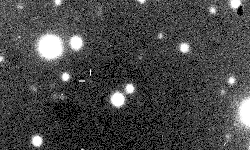Euanthe (moon)
Euanthe /juːˈænθi/, also known as Jupiter XXXIII, is a retrograde irregular satellite of Jupiter. It was discovered by a team of astronomers from the University of Hawaii led by Scott S. Sheppard in 2001, and given the temporary designation S/2001 J 7.[3][1]
 Discovery images of Euanthe by the Canada-France-Hawaii Telescope in December 2001 | |
| Discovery[1] | |
|---|---|
| Discovered by | Scott S. Sheppard et al. |
| Discovery site | Mauna Kea Obs. |
| Discovery date | 11 December 2001 |
| Designations | |
Designation | Jupiter XXXIII |
| Pronunciation | /juːˈænθiː/ |
Named after | Ευάνθη Eyanthē |
| S/2001 J 7 | |
| Adjectives | Euanthean /juːænˈθiːən/ |
| Orbital characteristics [2] | |
| 20799000 km | |
| Eccentricity | 0.232 |
| −620.6 days | |
| 130.5° | |
| Inclination | 148.9° |
| 271.0° | |
| 316.0° | |
| Satellite of | Jupiter |
| Group | Ananke group |
| Physical characteristics | |
Mean diameter | 3 km |
| 22.8 | |
Euanthe is about 3 kilometres in diameter, and orbits Jupiter at an average distance of 20,465 Mm in 598.093 days, at an inclination of 143° to the ecliptic (142° to Jupiter's equator) with an eccentricity of 0.2001.
It was named in August 2003 after Euanthe, who was the mother of the Graces, according to some Greek writers.[4]
Euanthe belongs to the Ananke group, retrograde irregular moons that orbit Jupiter between 19.3 and 22.7 Gm, at inclinations of roughly 150°.
References
- Brian G. Marsden (May 15, 2002). "MPEC 2002-J54: Eleven New Satellites of Jupiter". International Astronomical Union Minor Planet Center.
- S.S. Sheppard (2019), Moons of Jupiter, Carnegie Science, on line
- Daniel W. E. Green (May 16, 2002). "IAUC 7900: Satellites of Jupiter". International Astronomical Union.
- Daniel W. E. Green (August 8, 2003). "IAUC 8177: Satellites of Jupiter, Saturn, Uranus". International Astronomical Union. Archived from the original on March 27, 2012.
This article is issued from Wikipedia. The text is licensed under Creative Commons - Attribution - Sharealike. Additional terms may apply for the media files.